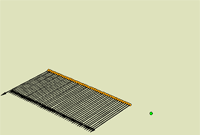"Tunning of exchange coupling
with hydrogen: playground for study of low-dimensional magnetism"
Summary
The aim of the project is the investigation of the fundamental
nature of low-dimensional magnetism using metallic multilayers with
reversibly tunable (via hydrogen loading) interlayer exchange interaction.
These systems present a new class of structures where continues
transition from quasi-two-dimensional to three-dimensional magnetism
can be realised experimentally
We will grow Fe(Cr)/V superlattices of high epitaxial quality by
magnetron sputtering and MBE techniques. Being placed into the hydrogen
atmosphere, these systems accumulate hydrogen in the V spacer, increasing
the V-lattice constant up to 10% in the direction perpendicular
to the multilayer plane. Magnetic blocks (Fe or Cr) do not accept
H and their spatial structure remains unchanged. As a result, interlayer
exchange coupling between magnetic layers can be changed in Fe/V
structures from ferromagnetic to antiferromagnetic and vice versa.
Tuning of H concentration, which can be achieved by a slight variation
of the external hydrogen pressure, leads to a continuous transition
from quasi-two-dimensional to three-dimensional magnetic structure.
This transition, including critical behaviour near the Curie point,
will be studied using complimentary experimental methods (Polarised
Neutron Reflectometry (PNR), MOKE, EXAFS, Anomalous Wide Angle X-ray
Scattering (AWAXS), Resonant X-ray Magnetic Scattering, Moessbauer
Spectroscopy, Magnetometer and Magneto-resistance and High frequency
electromagnetic measurements). The magnetic and chemical structure
of the interface, its dependence on the regimes of the epitaxial
growth and annealing will be additionally studied in situ by Spin
Polarised Secondary Electron Emission (SPSEE), Spin Polarised Auger
Electron Spectroscopy (SPAES), and by Scanning Tunnelling Spectroscopy
with atomic resolution.
The theoretical description will include modeling of the epitaxial
growth and hydrogenation process with subsequent self-consistent
calculations of magnetic structure on the basis of ab initio and
model Hamiltonian approaches. Ab initio methods will be used for
calculations of the set of model structures and fitting of the parameters
of semi-empirical models whereas model Hamiltonian calculations
will be performed for the systems, which include several thousands
of non-equivalent atoms for realistic modelling of interface roughness
and alloying. After taking a corresponding average it will allow
to interpret the data of different experimental methods within the
framework of one theoretical approach.
Detailed quantitative information about magnetic and chemical structures
on the atomic scale and its evolution with hydrogen loading obtained
using consistent experimental and theoretical studies will reveal
new fundamental information on the Spin Density Wave material (Cr)
and Ferromagnetic material (Fe) under conditions of continuous "reduction
of dimensionality".
Participants
- Ruhr-Universitaet Bochum, Department of Physics and Astronomie,
Bochum, Germany.
(Prof. Hartmut Zabel, co-ordinator)
- Uppsala University, Department of Physics, Uppsala, Sweden.
(Prof. Bjorgvin Hjorvarsson)
- Gerhard-Mercator-Universitaet Duisburg, Faculty of Natural Sciences,
Duisburg, Germany.
(Prof. Werner Keune)
- CNRS, Institut Physique et Chimie des Materiaux, Strasbourg,
France.
(Dr. Claude Demangeat)
- Heinrich-Heine-Universitat Duesseldirf, Faculty of Mathematics
and Natural Sciences, Duesseldorf, Germany.
(Prof. Erhard Kisker)
- Johannes Gutenberg-Universitaet Mainz, Institute of Nuclear
Chemistry,Fritz Strassmann-Weg 2, 55128 Mainz,
( Prof. Tobias Reich)
- St.Petersburg State University, ICAPE, St.Petersburg, Russia.
(Prof. Valery Uzdin)
- Institute of Metal Physics, Ural Division RAS, Ekaterinburg,
Russia.
( Prof. Vladimir Ustinov)
- Physical-Technical Institute of Ural Branch of Russian Academy
of Sciences, Udmurtian State University, Izhevsk, Russia.
(Prof. Anatoly Arzhnikov)
- St. Petersburg Technical University, Department of Physics and
Mechanics, St. Petersburg, Russia.
( Dr. Vladimir Petrov)
- Joint Institute for Nuclear Research, Frank Laboratory of Neutron
Physics, Dubna, Moscow Region, Russia.
(Prof. Viktor Aksenov)
|

